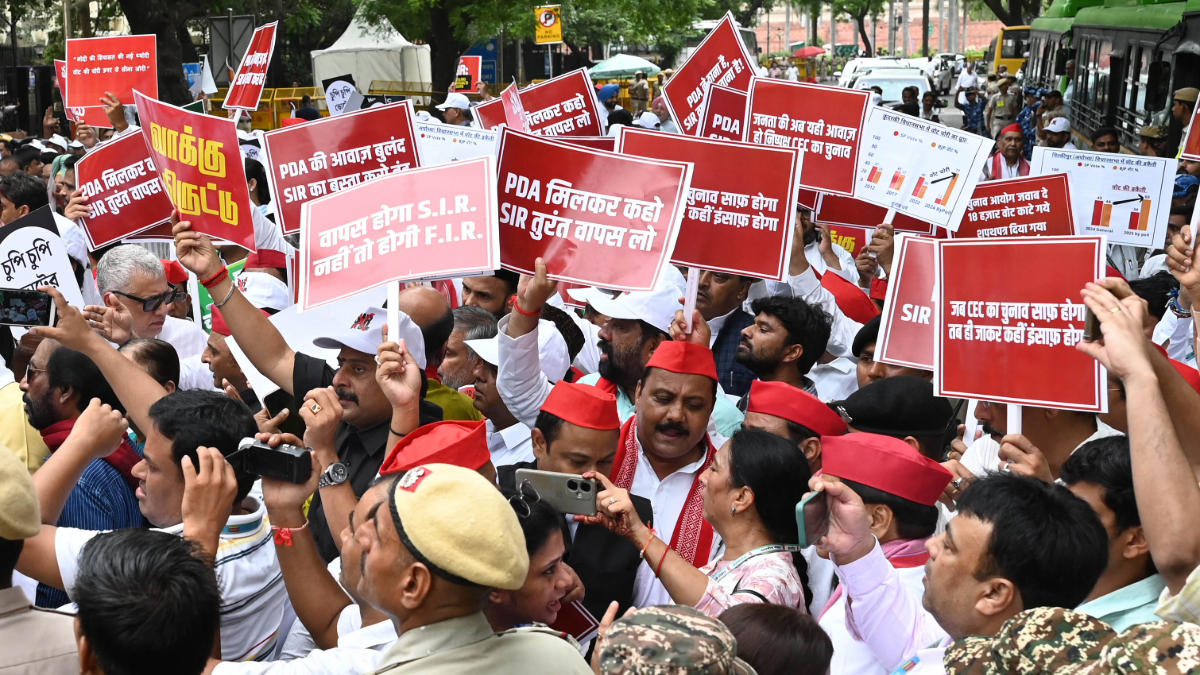High Bar to Establish Identity in India's Elections Threatens Disenfranchisement
Amber Sinha / Aug 21, 2025Amber Sinha is a contributing editor at Tech Policy Press.

NEW DELHI, INDIA - AUGUST 11: Members of Parliament from Opposition parties in both the Lok Sabha and Rajya Sabha during their protest march from Parliament to the Election Commission office against the Special Intensive Revision (SIR) of electoral rolls in poll-bound Bihar and allegations of "voter fraud" during the 2024 Lok Sabha elections. (Photo by Sonu Mehta/Hindustan Times via Getty Images)
India’s domestic electoral politics entered a turbulent phase over the last several weeks as the Election Commission of India (ECI) seeks to disenfranchise millions of existing voters. The commission recently conducted what it called a Special Intensive Revision (SIR) of the electoral rolls in the northeastern state of Bihar before the state legislative assembly elections, expected to be scheduled in November this year. Central to this issue is the question of setting inclusive thresholds for the enrollment and verification processes in any digital identification system, and the controversial role that Aadhaar plays as a ‘trustworthy’ ID in India.
This SIR conducted in Bihar is currently a subject of judicial challenge before the Indian Supreme Court, reports suggest that the opposition parties are considering bringing an impeachment motion against the Chief Election Commissioner, Gyanesh Kumar, and the Leader of Opposition, Rahul Gandhi is leading key opposition parties in a 16 day-long tour across the state of Bihar to highlight the alleged assault on the people’s right to vote.
What is the SIR process?
Section 21 of the Representation of the People Act, a key piece of legislation governing elections in India, empowers the ECI to prepare and revise electoral rolls, including conducting special revisions whenever necessary. According to the ECI, rapid urbanization and migration over the past two decades have led to large-scale additions and deletions in voter lists, increasing the risk of duplicate entries. Since the Commission has a constitutional duty to ensure that only eligible citizens are enrolled, it has decided to launch a Special Intensive Revision (SIR) across the country, beginning with Bihar.
The SIR process has led to the deletion of 6.5 million voters from the electoral rolls in the state of Bihar, on grounds ranging from death or having migrated to lacking documents. This process is intended to be carried out in the entire country, and political lines around the need to weed out duplicate or fraudulent registrations from the rolls on the one hand, and that of systematic exclusion of marginalized groups on the other, are being hardened. Significantly, in his independence day speech this month, Prime Minister Narendra Modi repeated rhetoric from last year’s national elections, highlighting the need to carry out a ‘demographic mission’ to remove ‘infiltrators’ from the voter rolls.
Universal franchise in India
At the time of India’s first elections in 1952, more than 80 percent of the electorate was illiterate, and most had little or no property. Extending the right to vote to every adult citizen was by no means an obvious choice. In fact, other democracies took much longer—women in the US only gained suffrage in 1920, over a century after its first elections; in the UK, women received broader voting rights in 1932; France and Italy had followed suit even later. At independence, Australia still denied voting rights to its Indigenous people, while Switzerland did not allow women to vote. Yet, from 1952 onwards, even India’s most marginalized communities were granted the right to vote.
This commitment was embedded in the Constitution itself. Article 324, which empowers the Election Commission of India (ECI), came into force on 26 November 1949, two months before India became a Republic, and the ECI was formally established the very next day, 25 January 1950.
Over 19 general elections and numerous state elections, peaceful transfers of power have become routine in India. But this outcome was not guaranteed in the 1950s. Many new nations struggled with electoral instability, yet India’s system gained credibility thanks largely to the ECI’s efforts. For the first elections in 1952, it faced the daunting challenge of preparing electoral rolls for an electorate where 85 percent had never voted before and more than 15 million had been displaced by Partition.
This work began even before the ECI was created, under the Constituent Assembly Secretariat (CAS), a small unit of the Constituent Assembly. Historian Ornit Shani notes that the CAS’s responsiveness to voter registration challenges helped cultivate trust in the electoral process. For instance, when it was discovered that rigid residence rules would exclude large numbers of refugees, the CAS decided to allow enrollment based simply on a declaration of intent to reside permanently in a village or town.
Despite frequent obstacles—provincial governments imposing arbitrary fees or officials engaging in exclusionary practices—the CAS maintained transparency, investigated complaints, summoned errant officials, and publicized corrective actions. This early openness and accountability, later carried forward by the ECI, built a durable faith in Indian democracy. As Dr. S. Radhakrishnan described it, democracy in India developed not just as a system of rules, but as a “habit of mind” rooted in sensitivity to people’s varied demands.
Contemporary contrasts
Recent experiences, however, highlight how fragile this trust can be. In Telangana’s 2015 assembly elections, nearly 10 percent of voters were removed from the rolls, and by 2018, over three million people may have been disenfranchised. Similar “clean-up” drives have occurred in Andhra Pradesh, Uttarakhand, and Rajasthan. These deletions often stemmed from linking Aadhaar numbers to voter IDs. Security researcher Srinivas Kodali challenged this practice in court, warning that reliance on automated processes left citizens without recourse to contest wrongful deletions.
The Aadhaar-linked “purification” of electoral rolls assumed that Aadhaar’s biometric database was flawless and should override all others. But government records frequently contain errors—misspellings of names, incorrect addresses, or outdated family details. Treating such mistakes as fraudulent and summarily deleting entries undermines trust in the system.
Manipulation is also a risk. In Andhra Pradesh, investigations suggested that party workers used the SevaMitra app to profile voters and identify those unlikely to support their party. They would then file Form 7 objections to have these voters removed from the rolls. Although the Election Commission requires verification before deletion, widespread reports suggest that safeguards are often weak, leading to wrongful disenfranchisement.
Supporters of the SIR in its current form argue that the RP Act permits only those citizens who are “ordinarily resident” to be enrolled in a constituency’s electoral roll. Accordingly, migrants who relocate for extended periods due to work or education should be registered in the constituency of their present residence, as outlined in the RP Act and the RER.
On the other hand, critics point out that the RP Act also clarifies that individuals who are “temporarily absent” do not lose their status as “ordinarily resident.” Many migrant workers move within or outside the State for employment but return periodically to their native place, where their families and property often remain, and where they wish to retain voting rights. In fact, as recently as January 2023, the Election Commission expressed its willingness to explore a remote voting mechanism for such migrants, provided it is technologically viable and gains consensus among stakeholders.
This contrast between the openness of the early electoral administration and the opaque, technology-driven exclusions of today underscores how easily the democratic “habit of mind” can be eroded when trust and transparency are replaced by blind reliance on flawed design.
The dispute over identification
One of the primary questions that the court is dealing with is whether Aadhaar cards (along with the Electoral Photo Identity Card (EPIC), and ration card) can serve as foundational records for the purpose of verification. The primary issue is what forms of identity documents establish sufficient trust in this context to allow an individual to access their right to vote.
The popular meme by Peter Steiner in The New York Times, ‘On the internet, nobody knows you’re a dog,’ is an oft-quoted phrase in digital identity design discussions. As stated in the latest version of the Levels of Assurance technical guidelines by NIST2, a cybersecurity framework, “when accessing some low-risk digital services, ‘being a dog’ is just fine; while other, high-risk services need a level of confidence that the digital identity accessing the service is the legitimate proxy to the real life subject.” Increasingly as digital identity solutions are used in exercise of both civil and political rights (use of identity in elections), and economic and social rights (access to essential benefits and services), the denial of services due to faulty design as well as failures of identity solutions imposes both real-life human costs as well as denial of fundamental human rights. Rather than a top-down approach where the ‘business’ or ‘state’ interests of those in charge with making decisions about what level of assurance to use dictates the design of identity solutions, it is imperative that levels of assurance are designed with ‘inclusivity’ as its guiding principle.
Petitions before the Supreme Court pointed out that the ECI cannot shift the burden of proof of citizenship on the voter. In an inclusive 1995 judgment in the matter of Lal Babu Hussein v. Electoral Registration Officer, the Supreme Court had already established protocols that Electoral Registration Officers must follow. According to the court’s directions, if a person whose citizenship is under question is found to have been listed in the most recent electoral roll, the ERO or any other official conducting the inquiry should recognize that all necessary checks for inclusion would already have been carried out. Therefore, this fact should be given significant weight before issuing a notice or initiating further proceedings.
Authors
